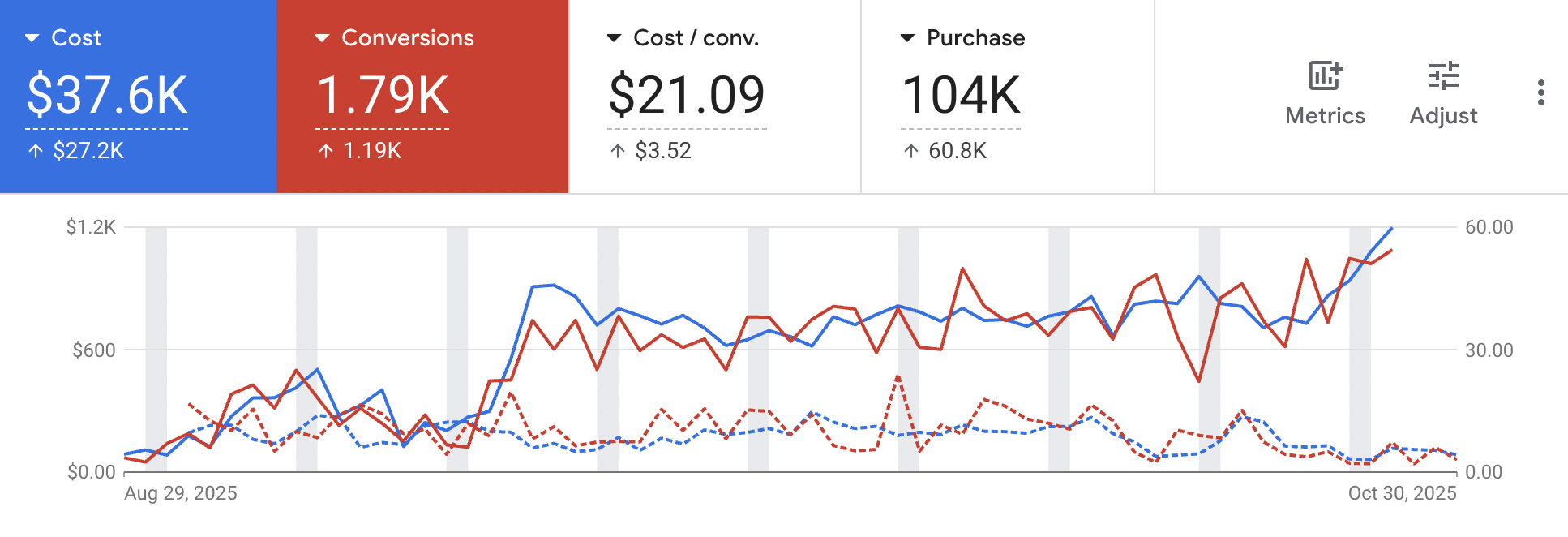If you’ve spent any time in DTC ecommerce, you’ve probably seen the obsession with ROAS. It’s the number that gets plastered in reports, repeated in meetings, and used as the ultimate indicator of success. If the ROAS looks good, everyone feels good. If it dips, panic sets in.
The problem is that ROAS doesn’t tell the whole story. It’s a snapshot, not a strategy. And when brands treat it like the only metric that matters, they end up boxing themselves into a corner where growth starts to stall.
I’ve seen this happen more than once. A campaign is performing well, sales are strong, and the team is proud of the numbers. But instead of scaling, they clutch that ROAS like it’s made of glass. Budgets freeze. Expansion stalls. And the ceiling starts to lower, even if the campaign still has room to grow.
ROAS is a signal, not a finish line
When you increase ad spend on a high-performing campaign, ROAS will almost always dip. Not because the campaign suddenly stopped working, but because the audience pool is expanding beyond your most efficient segment. This is a natural part of scaling.
But if your team is locked into protecting one “perfect” number, it’s easy to mistake a healthy dip for a problem. And that’s where opportunity dies. The focus shifts from growth to preservation, and you miss the chance to reach a bigger market.

This chart is a perfect visual example of why campaign scaling matters.
- Solid lines = current period
- Dotted lines = previous period
Even with increased spend ($37.6K vs. $10.4K previously), the chart shows a strong upward trend in both cost and conversions. This means the campaigns didn’t just spend more—they generated more total revenue.
While cost per conversion went up slightly (from ~$17.57 to ~$21.09), the total conversions jumped by over 1,000—which is the tradeoff that happens when you scale campaigns intentionally rather than chasing a fixed ROAS number.
This is a textbook example of why brands shouldn’t panic when ROAS dips slightly during scaling. When done right, scaling increases overall profit, not just efficiency on paper.
Vertical vs. horizontal scaling
There are two main ways to scale campaigns.
Vertical scaling means increasing the budget on what’s already working. It’s fast and can drive more sales, but efficiency will start to level off. Your ROAS may go down even though total revenue goes up.
Horizontal scaling means adding more campaigns—new angles, new audiences, new funnel stages. It spreads the weight across multiple touchpoints instead of leaning too hard on one campaign. This keeps performance more stable and gives you room to experiment without tanking your overall ROAS.
Horizontal scaling also builds resilience. If one campaign starts to fatigue, the others can keep performance steady while you refresh creative or messaging. It’s a more flexible, long-term way to scale.
Setting real goals
If your only target is “maintain a ROAS of X,” your marketing strategy is already fragile. A better question is: what revenue goals are we actually trying to hit? How much ROAS compression can we live with while scaling? How do we balance efficiency with expansion?
When you set clear growth goals and understand the trade-offs, ROAS becomes a guide, not a handcuff. You’re no longer trying to protect a single number—you’re steering toward a bigger picture.
Let ROAS Work For You, Not Against You
ROAS can be a helpful signal, but it was never meant to be the finish line. When you let one number dictate your entire strategy, you don’t actually protect your growth—you limit it. Scaling means accepting that efficiency will shift as your reach expands. That’s not a failure. That’s how growth works.
Smart brands don’t freeze when the ROAS dips a little. They understand why it’s happening, plan for it, and keep moving. They build flexible campaign structures, set clear revenue goals, and make scaling decisions with intention—not fear.
The brands that win aren’t the ones with the prettiest ROAS dashboards. They’re the ones willing to let go of vanity metrics and lean into sustainable growth.
So the next time someone panics over a small dip in ROAS, ask the better question: Is our strategy built to grow—or to stay comfortable?

%402x.svg)





